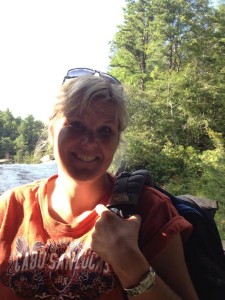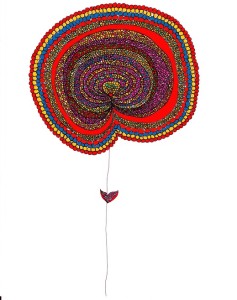Mary Akers: Hi, Kristin, thanks for agreeing to speak with me today about your SOS piece “Anxiety.” I loved this piece on first read and love it more each time I reread it. Do I remember correctly–that you submitted it as a prose poem? I was thinking you had, but either way, my first question works. With so many possible descriptive categories for a piece like “Anxiety” (flash fiction, micro-fiction, short-short, prose poem), how do you arrive at a form for your work? Does the subject dictate the form? The execution? How do you decide what form your work will take?
Kristin Laurel: Hi, Mary, thank you so much for your kind words and for including “Anxiety” in r.kv.r.y. And you want to hear about my process, too? Wow. I’m truly honored.
I think I did submit this piece as a prose poem. It was exciting to see that your SOS submissions were not limited to prose, poetry, flash fiction, etc. For me, there are basically three categories: Poetry, prose and “I don’t fit in.” I discovered contemporary poetry and started writing about eight years ago; I was also writing these short, intense paragraphs which I learned were called “prose poems.” I have a short attention span, prose intimidated me and I figured why waste so much time writing a whole chapter when I could do it in a paragraph or stanza. Easy right? A teacher once told me a poem is like a stream, a prose poem is like a pond. I guess that would make prose an ocean, or at least a big lake, but I love that analogy. All I can do is throw the words into the water and hopefully make some waves or watch them sink. So I guess the answer to your question, how do I arrive at a form, is for me, largely intuitive.
Does the subject dictate the form? The execution?
Hmm. That sounds like a great topic for an AWP panel or an English professor. I’m not academically trained; I don’t hold an MFA or anything so I can only answer this from my own perspective. I believe there are some subjects that benefit best from brevity and line breaks. I want to breathe in the white space, relish in the imagery, pay close attention to cadence. There are other times, when I don’t’ want any preference to line breaks. I want to pack in the absurd and quirky, blast the reader with emotion, images and chaos. These are usually the “prose poems” that I write and I enjoy writing them. There are times I find a poem cannot hold everything I want it to; I have a tendency to try and fit too much into a poem. I’ve been writing more prose lately because my subject matter is demanding more room.
I write heavily from personal experience and obsession and have come to believe we must write for ourselves, first. However, I do feel an obligation to serve as witness. For example, I’ve spent the last several years writing about my sister’s two young boys who were killed in separate, tragic, accidents. The subject, the driving force for so many of my poems is grief. The other driving force is to elegize these two boys so they are never forgotten. Some of these writings have been executed into poems and sent out into the world, some I will always keep to myself, and some are not working in their current form. There are a myriad of other themes I feel compelled to write about, such as the resilience I’ve witnessed in my family, the spiritual quest that this has brought about in all of us and some of these themes seem to be working better in a prose-like or “I don’t fit In” form. I just keep telling myself the story comes first, the form will come later. And the subject—these boys, and this story—are important. I also rely heavily on my writing group and seem to always need a teacher or writer whose work I admire to help guide me in the right direction. If it weren’t for the support from my community of writers I don’t think I would have the courage to execute anything.
I hope my answers weren’t too long. These are great questions.
MA: Not too long at all! I love your answers. As real as the stream-of-consciousness thoughts are in this piece, they are also quite humorous. I find that funny is often an effective way to get serious quickly–if you know what I mean–it’s like we let our guard down as readers when we laugh and that opens the door for the gut punch. Would you care to comment on that idea?
KL: Well, I’m so glad you saw the humor. My daughter read it and told me I was weird. Ha ha. And what an amazing insight; I’ve never consciously thought about humor as an effective way to get serious quickly. However, I have used it as camouflage; a way to cover up too much intensity. I tend to gut punch first and then think, “Uh oh, I better give us all a break and try to lighten up and be funny.”
MA: Speaking of funny, do you often write humorous work? Do you find it easier or harder to be funny when writing?
KL: This is all making me think I should be writing funnier poems. Ha Ha. I’ve written about heavy topics such as abuse, suicide, attempted murder etc., and of course, the deaths of my beloved nephews. I’ve also written about some pretty tragic experiences as an ER nurse and flight nurse. However, I do find a sense of humor has trickled into even my darkest writings. I think there is an inherent need for humor during tragedy. I appreciate humor so much. In the EMS and medical world, there is this undercurrent of dark humor that might seem cruel to those on the outside, but for the providers dealing with the traumatic situations on a daily basis it’s an extremely important coping mechanism.
It’s much easier, for me, to be funny in the external world. Perhaps it’s because the internal world of writing gives me a voice for those aspects of myself I don’t go around sharing. I mean, it’s much easier to crack a joke with a cashier than to ask, “So…how is your soul today, really?”
MA: Your answer makes me think you might like the work of Elissa Schappell. Have you ever read her? Her prose is precise, dark, and very funny–with that killer gut punch. If you haven’t read her work, I think you might like it a lot. (An aside, I know, but what better aside is there than a personalized author recommendation?)
Anxiety, as a force, is such a real, palpable, living-breathing thing–a heavy weight–and yet it’s mostly invisible to the outside world. I see this piece of yours as a way of making the invisible visible. Does that idea resonate with you?
KL: As far as anxiety, I worry and let my mind run too much. I think many of us do. I even worried about the title; maybe I should have titled it “ADHD” or “That damn wasp that wanted to kill me.” I worried my laughing at my own “anxiety” might seem like I’m over-generalizing or making fun of those who suffer from severe or debilitating anxiety disorders like PTSD etc. I’ve personally never had a panic attack but I’ve witnessed many. Nonetheless, I think we all have crazy thoughts sometimes—See look at mine? So yes, I love the idea of making the invisible visible. That idea resonates with me immensely.
MA: When I choose illustrations for the work in r.kv.r.y., authors often have strong reactions to the images I’ve chosen for their work. They may connect with it in a way I couldn’t have known. I think this says something about the powerful human desire to find connections between disparate emotions, art forms, etc. What did you think of the image used to illustrate your writing?
KL: Oh Yes. I love that idea, the human desire of finding connections. I think that’s why so many of us gravitate toward art in the first place. And what an interesting observation because it wasn’t conscious; when you placed Laura’s great piece next to mine I immediately tried to merge them. I tried to make her piece anxious and funny. I was thinking something like “Yes, yes -that’s what it looks like inside my head; all of those colorful neurons. It’s a good thing those circles have a home in that one big circle head. I wouldn’t want to lose my circles. It’s all about the circles. We are all connected” something like that.
If I look at it separately I can see it as a balloon with a ribbon tied to a piece of string. But mostly I see it as a flower and on the stem is a single leaf. It’s full of details but it’s also abstract. I find her piece vibrant, beautiful and busy, busy, busy. So of course, I love it!
MA: And finally, because we are a recovery-themed journal, what does “recovery” mean to you?
KL: I love this question. First of all, I’m so glad you use the word “recovery” instead of “healing.” I’m starting to think we don’t truly “heal” from anything. And being healed sounds so absolute, so curative. I think recovery is perpetual and universal. From the moment we are born, we are recovering…“Okay, I’m out of the womb, now what? I have to breathe, I have to eat, I have to eliminate, I have to grow.” So recovery to me, first and foremost means growth. Some other characteristics which come to mind in terms of effective recovery are resilience, grit, openness, connectedness, fearlessness, and gratitude.
From an artistic standpoint, I was recently asked why I feel compelled to revisit tragedy so often. Having examined so much tragedy, it has made me appreciate the tender moments in life even more. As Gregory Orr explains in one of my all-time favorite books, Poetry as Survival, Intense emotion harnessed with creativity can transcend. I believe this wholeheartedly.
MA: Yes! When I’m in a situation where I have to give an elevator pitch for the journal, I say, “It has a theme of recovery, but broadly defined. And if you’ve been born, you’re recovering from something.” Thank you, Kristin. This was delightful.
KL: Thank you so much Mary, for these stimulating questions and for the real, accessible and important work you are doing at r.kv.r.y..



Pingback: “Anxiety” by Kristin Laurel | Rkvry Quarterly Literary Journal